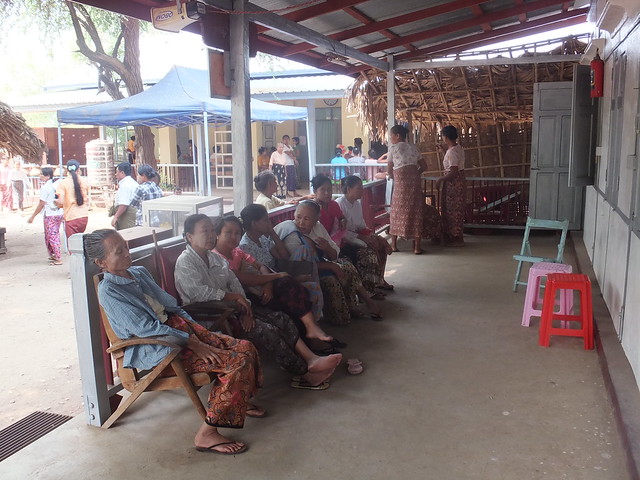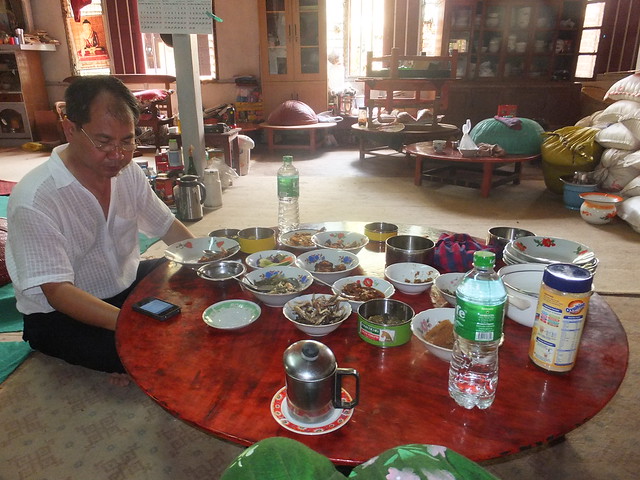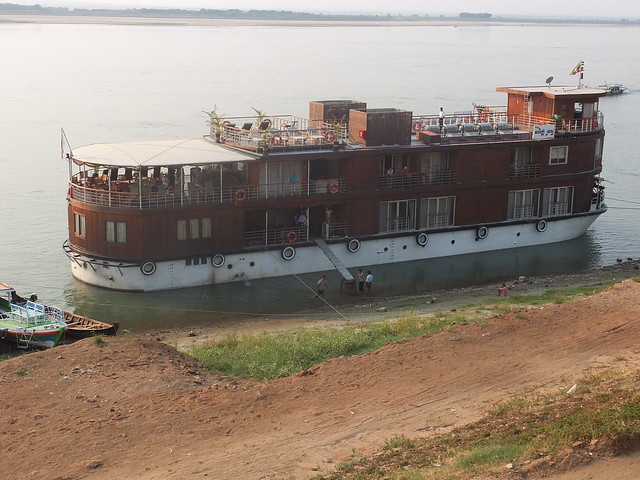Click on any picture below for an uncropped image.
The Monastery ‘Hi-Ace’ and driver picked me up at seven o’clock. We started on a series of sandy tracks, past dozens of pagodas including the famous Ananda Temple. At that time of day, the tourist operation hadn’t yet started but the army of sellers were beginning to get prepared. We turned onto the dual carriageway Anawrahta Road which, rather incongruously, slices across the Bagan Plain with its myriad pagodas from Old Bagan to the township of New Bagan, Nyaung Oo.
New Bagan, as its name implies, is a recent creation unashamedly partly devoted to tourism, with lots of restaurants and small guest houses. It has the administrative offices, a golf club and a District Hospital. There’s a major intersection controlled by traffic lights (and often a policeman, too) where we turned onto the dual carriageway leading towards the Mount Popa area. We passed the junction with the road to the airport and then the junction with the road to the railway station. But after our rather grand exit from the town, including passing through a pair of gaily-decorated reinforced concrete ceremonial arches, the road quickly deteriorated to the usual strip of tarmac barely wide enough for two vehicles to pass without using the unmetalled verges. Soon, we came to a section being worked on where the surface was loose sand. Women road workers armed with a simple wooden rake lined each side of the road – their function appeared to be to smooth the ruts as they appeared on this busy road.
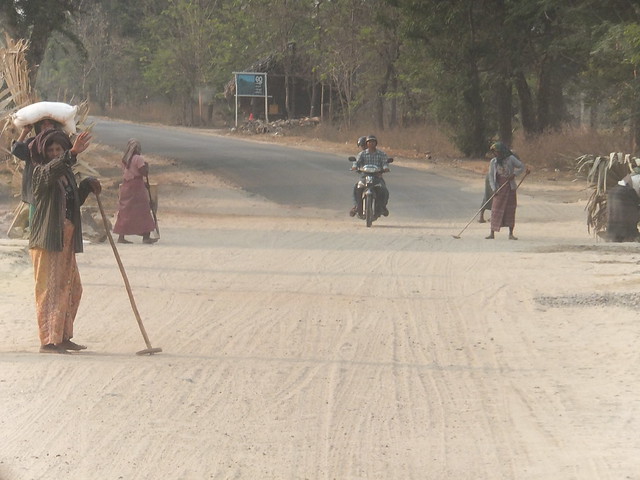 Women road workers with their rakes.
Women road workers with their rakes.
After a few hundred yards, we were back on the usual narrow tarmac strip until our left turn onto the road to Chauk Kan.
Chauk Kan
The road to the village was loose sand and deeply rutted in places without the benefit of anybody to rake out the ruts. It’s a mile or so to the main village from the turn-off but it seemed much further. The area is flat with a variety of trees dotted around. There are also very temporary-looking dwellings with woven walls, sometimes with a short brick chimney indicating a still for producing ‘Toddy’ - the local rum produced from the exudation of the ‘Toddy Palm’ tree. There's a brief description of the production of 'Toddy' in my earlier report here. Some of the land we were passing through was scrub but large areas were neatly tilled with regular narrow furrows produced by two ox hauling a wooden plough controlled by the farmer. I’ve never seen anything but animal power used for ploughing.
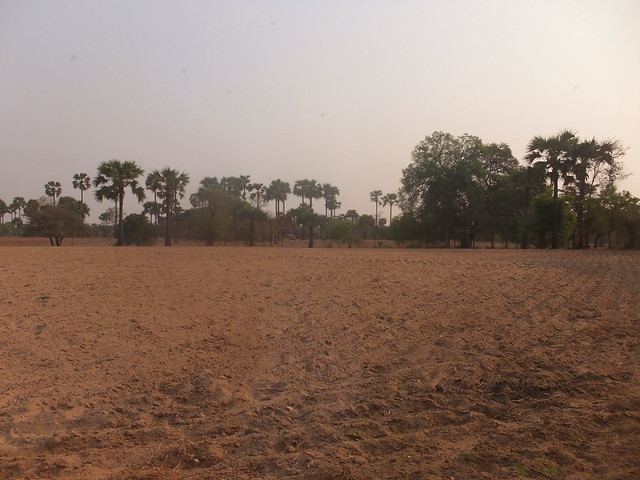 Neatly-tilled land flanks the road to Chauk Kan.
Neatly-tilled land flanks the road to Chauk Kan.
Equally, vehicles are normally carts hauled by two oxen – great wide things made wider by axles protruding from the cartwheel hubs. Wear in the hubs is often quite pronounced allowing wheels to wobble in an alarming manner as the oxen slowly drag their load. I noticed that some of the carts had been fitted with modern pneumatic tyres. There are few cars – the better-off have the ubiquitous motor bicycle, often with three or four people aboard but, other than the pick-up trucks which move goods, people (or, more often, both at once), walking is the standard method of getting around.
We arrived at Chauk Kan. I’d been before (October 2011 vist and February 2013 visit), helping with distributions to the enthusiastic children but, this time, the children were on holiday. The original building was Government-provided for basic education, but an additional building donated by Mr. and Mrs. Henseler via ‘Road to Mandalay’ opened in February 2010 (brief report here). I was greeted by the smiling headmaster. Builders were now doubling the size of the 2010 building. In one classroom, a wooden table had been set up with a plastic tablecloth, water, biscuits, grapes and a large bunch of bananas. The Burmese are a generous and hospitable people.
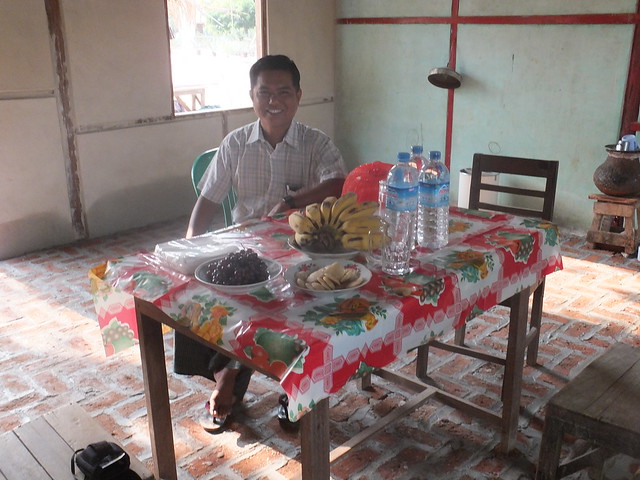 The Chauk Kan Headmaster.
The Chauk Kan Headmaster.
The structure of the new extension was complete. Three builders were completing the brick floors. Bricks had been laid and levelled in a ‘parquet floor’ pattern. They were engaged in cementing the gaps between the bricks.
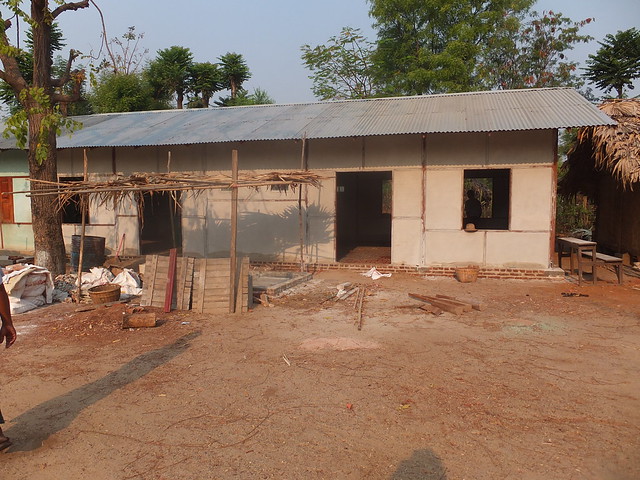 The New Extension at Chauk Kan.
The New Extension at Chauk Kan.
I noticed that a large, new water tank had been installed adjacent to the original school building. Guttering had been added to one end of the school building and the adjacent building with blue plastic rainwater pipes delivering the water to the tank, which could alternately be filled via a hatch. A marble plaque on the tank confirmed that this was a donation from Margaret and Eric Knowlden in Sydney.
Htee Pu
Next, we were off to Htee Pu. I was a little surprised when the Chauk Kan headmaster jumped in the front of the vehicle – he was clearly coming with us. So it was back to the main road, carry on towards Mount Popa and then turn off on another rutted track to reach Htee Pu. I was invited into the monastery building where the Head Monk had arranged for water and food to be laid out on a low table. In addition, two girls were summoned to waft cooling air over their perspiring guest with hand fans. The Headmaster was away on a Training Course.
 The Head Monk at Htee Pu.
The Head Monk at Htee Pu.
Then we walked around what is becoming quite an extensive set of buildings. My first visit was in 2009). I've been back in 2010 (when a new building was officially opened), again in 2011 and again in 2012.
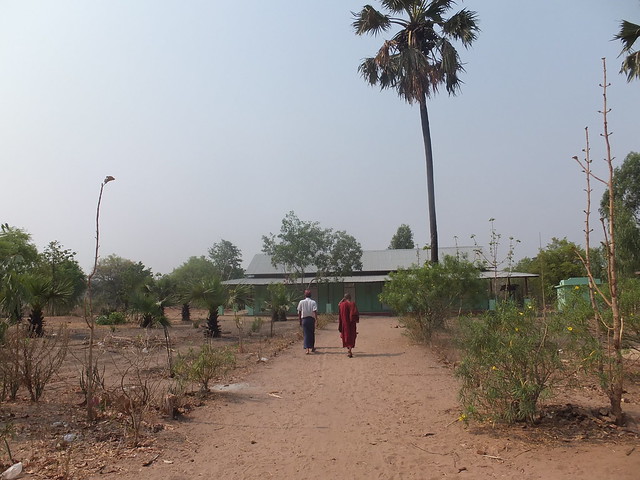 The 2010 School Building.
The 2010 School Building.
A large water tank had also been installed at Htee Pu, donated by the Clulees and friends from Samoa. There was a small set of excavations in progress for what looked like another toilet building with septic tank. I also noticed that the large Assembly Hall had received some external embellishment since I was last here.
The Chauk Kan headmaster was still with us when we left Htee Pu. There were a crowd of people around a parked pick-up truck which looked as if it had just arrived. Whether this was a scheduled ‘local bus’ or a special arrangement, I’m afraid I didn’t discover.
Nga Paing
When we reached the main road, we travelled along it to the junction with the sandy track to Nga Paing.
This was my first visit to Nga Paing and I was warmly welcomed by what I took to be the headmaster, although he was covered in spots of white paint and had clearly been involved in emulsioning. We passed existing school buildings – one had a roof of banana leaves whilst the other had a more durable ‘tin roof’. Both were partly open-sided and the remaining walls woven. It was clear that my host was, quite rightly, very proud of the new building – proper foundations supporting a substantial wooden frame with brick infill, cemented over to protect the face of the bricks and painted magnolia. A group of cheerful workers (or perhaps teachers) were completing the painting. Broad steps led up to a verandah at the front from which doors led to the school office and three separate classrooms. Concrete screed floors were provided throughout the building. Either side of the steps, balustrades with pre-cast concrete balusters were provided.
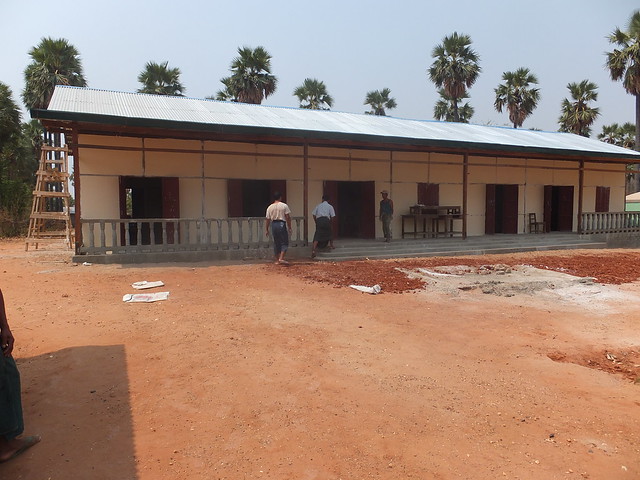 The New School Building at Nga Paing nears completion.
The New School Building at Nga Paing nears completion.
I was invited into the office, equipped with brand-new varnished wooden seating, a matching large storage cabinet and a low table loaded with water, food and green tea. The overall effect was most impressive. As requested, I added my name to an impromptu Visitors’ Book.
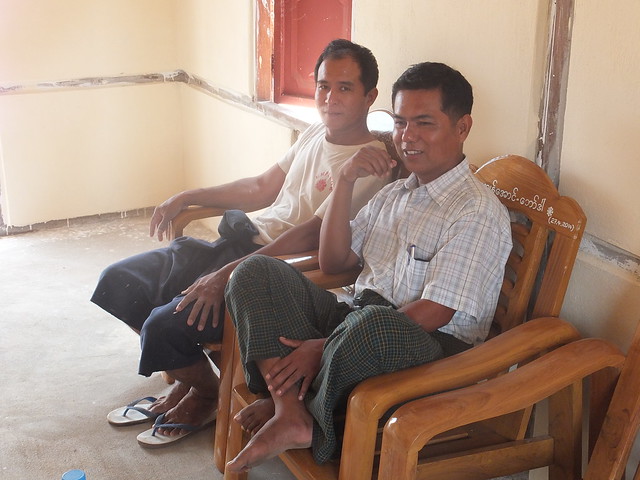 The Headmaster of Nga Paing and the Headmaster of Chauk Kan in the Office at Nga Paing.
The Headmaster of Nga Paing and the Headmaster of Chauk Kan in the Office at Nga Paing.
The school had already constructed a water tank, similar to those seen at the other two schools. This water tank was donated by Laura Daley from Australia.
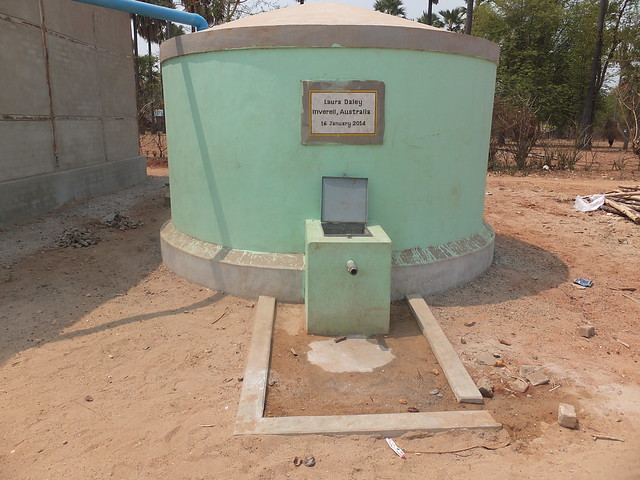 The Water Tank at Nga Paing School.
The Water Tank at Nga Paing School.
I’m always humbled to see the enthusiasm and commitment demonstrated by the Burmese, given some encouragement with really quite modest sums of money. Dr. Hla Tun’s watchword in determining which projects receive donated funds is always “effectiveness” – what in another area is called “getting the biggest bang for your buck”.
We set off back towards Bagan and dropped the Chauk Kan headmaster at the junction with the track to his village, then we retraced our route back to the Aye Yar River Resort.
The temperature had been around 42 degrees Celsius during the trip so, once back at my room, I was happy to stay there and relax. The ‘Pandaw’ was still at her moorings when I got back but, sometime during the afternoon, she quietly slipped away.
The following morning, I was to be transferred by road to Nyaung Oo Airport for the short flight to Mandalay and the next part of my adventure.
My Pictures
Aye Yar River Resort, Bagan.
Around Bagan, 2014.
Chauk Kan School.
Htee Pu, 2014.
Nga Paing, 2014.
More
Next Post describing this trip.
All my posts on Education Support in Burma.
[Revised 23-May-2014]
